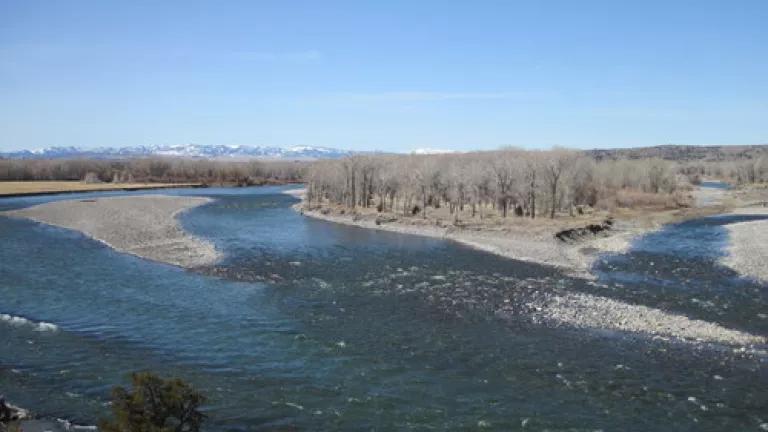
Less than a mile from our office, as I write this, snowmelt from the Northern Rockies screams downstream in the Yellowstone River. The Yellowstone – the longest undammed river in the lower 48 states – is an iconic, wild American river, and, around here, people simply call it The River.
The Yellowstone begins in the wild, roadless southeast corner of Yellowstone National Park in Wyoming. It flows north and east for almost 700 miles before it joins the Missouri River in western North Dakota. I have floated several miles of the Yellowstone, fished it many times, hunted ducks with my dog on it, backpacked alongside it with my wife and friends, and slept next to it. The Yellowstone River is an American treasure.
As such, when I returned this week after spending the long holiday weekend camping in and exploring a remote mountain valley near the Montana and Idaho border – blissfully free of cell phones, computers, and the never-ending American news cycle – I was stunned and saddened to learn that a disastrous oil spill occurred in the Yellowstone River late Friday night when an Exxon oil pipeline ruptured and puked tens of thousands of gallons of oil into The River.
For most Americans (myself included), I bet that oil spills merely register as some distant event they watch on CNN. Sure, BP’s Deepwater Horizon nightmare in the Gulf garnered weeks of intense media attention, but unless the affected area of the Gulf is tangibly relevant for you (i.e., you live there, you fish there, you vacation there, etc.), it’s probably just another far-off disaster that gurgles from the TV while you cook dinner.
So when I heard about the oil spill in the Yellowstone, my heart sank, as I gasped, “The Yellowstone? No, that couldn’t have happened.” Oil spills are supposed to happen far away, not on a river you know and love.
I spoke with my younger brother, Dan, about the Yellowstone fiasco yesterday. He lives in Massachusetts, but he fished and floated the Yellowstone with me last summer. Also shocked, he said, “I can’t believe it. You just don’t associate an oil spill with the Yellowstone. Knowing the river, this is different. This is really insane.”
And the more I read about the Yellowstone spill, the more I realize how many more rivers and communities – places where an oil spill today seems intangibly distant – are also at great risk of a disaster in their neck of the woods.
An article in today’s Bozeman Daily Chronicle states that “as officials grapple with the oil spill in the Yellowstone River near Laurel, the fact is that oil and gas pipelines and storage areas along the banks of Montana's pristine waters are almost as common as trout fishermen.”
There are thousands of miles of aging buried pipelines, and there have already been spills in the past year in Michigan, Salt Lake City, and multiple in Canada and the Great Plains.
Where will the next pipeline rupture occur?
Fortunately, the Bozeman Daily Chronicle article also notes that the Yellowstone spill “has some people questioning whether regulators can do more to put a buffer between American fuel and American water.”
As my colleagues Susan Casey-Lefkowitz, Bobby McEnaney, and Anthony Swift have written this week, America’s pipeline safety regulations can – and must – be strengthened to protect precious resources like the Yellowstone River.
Because the reality is that while our friendly multinational oil companies do a wonderful job feigning shock and awe each time one of their pipelines bursts, these “accidents” happen regularly. We need tougher regulations, and we need to think more critically about where these pipelines should be built.
We are not going to free ourselves of oil tomorrow, but we need to do a much better job regulating how our oil is supplied and transported across the country.
A good place to start (in addition to toughening state and federal regulations) is for the U.S. State Department to say no to TransCanada’s proposal to build its Keystone XL tar sands oil pipeline from northern Alberta in Canada through Montana, South Dakota, Nebraska, Kansas and Oklahoma all the way down to the refineries on the Gulf Coast of Texas.
Tar sands oil from Canada is more corrosive, more prone to spills, and more difficult to clean up than conventional oil. And – you’re not going to believe this – TransCanada wants its tar sands pipeline, like the Exxon pipeline that just popped, to go underneath the Yellowstone River in Montana (though TransCanada says not to worry because it would be buried deeper in the riverbed than the Exxon pipeline, use thicker steel and operate at lower-than-allowed pressures). Oh, and the Keystone pipeline would supply about 20 times more oil than the ruptured Exxon pipeline.
About 100 miles downstream of our office, Exxon’s busted oil pipeline just created a nightmare for the Yellowstone River and the farmers, ranchers, anglers, and communities downstream of the spill. While federal, state, local, and Exxon officials work to clean up and contain the spill, this tragedy had better serve as a highly caffeinated wake-up call that it’s time to strengthen our pipeline regulatory system and say no TransCanada's Keystone XL pipeline.
As the oil-stained water of the Yellowstone River shows us, we can’t afford not to.



